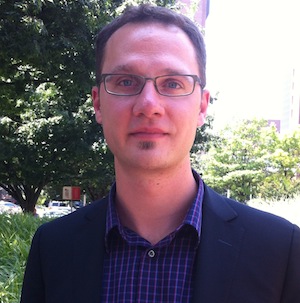Working as a physical therapist, I have sometimes struggled to understand why some of my patients with seemingly similar musculoskeletal injuries recover and why others develop chronic pain and disability. This question, as well as a range of others, ultimately prompted me to delve into the world of pain (research, that is) and explore how psychosocial and physiological factors shape the rehabilitation process. Some of my recent research has focused on the Fear Avoidance Model of pain (FAM), which suggests that the solution to my clinical quandary is rooted in how my patients interpret and respond to their pain. In a nutshell, the FAM suggests that individuals who don’t fear their pain will continue to engage in physical activities and therefore recover without difficulty. On the other hand, people that catastrophically interpret their pain (think, magnified threat, persistent negative thoughts and feeling helpless) begin to fear, and then avoid, movements and activities associated with their pain. The model suggests that over time these individuals avoid increasingly more activities, become physically deconditioned (a process known as Disuse Syndrome) and depressed, and that all of this nastiness helps perpetuate a downward spiral of increasing disability and pain.
In our recent Topical Review (Wideman et al., Pain 154 (11), pp. 2262-5) we reviewed some of the literature and theoretical assumptions related to the FAM and explore ideas for model advancement. One aspect that we explore is the cyclical relationships in the model (i.e. pain leads to catastrophic thoughts, which lead to fear, which leads to disuse, depression and disability, which lead to increased pain; repeat). There have only been a handful of studies that have systematically evaluated these cyclical relationships over time and, thus far, have largely failed to support them. On the other hand, there has been preliminary support for alternate, cumulative, relationships among the psychological risk factors in the FAM (i.e. catastrophizing, fear, depression). This work suggests that people with a greater number of elevated risk factors (e.g. those with elevated catastrophizing and fear and depression) have a worse prognosis than those with fewer risk factors. In my opinion, this alternate conceptualization of risk has enormous clinical appeal. The patients that we see in clinical settings often simultaneously face multiple factors that might impair recovery. Thinking about risk in this manner also facilitates the integration of risk-stratified interventions (such as the STarT Back approach) that can be matched to patients’ levels of cumulative risk.
A second aspect that we consider is the model’s dichotomous trajectories: one leading to pain and disability, the other leading to recovery from pain and disability. Research that samples non-clinical populations suggests that these two pathways don’t fully account for the variability between chronic pain and disability. This work suggests that many individuals live with chronic pain without experiencing pronounced disability or psychological distress. Related research suggests that these individuals may have resilience factors (think, high optimism, deep sense of purpose) that act as a buffer to the potentially detrimental aspects of pain. Consideration of both risk and resilience factors might therefore enable us to explain a wider range of recovery trajectories.
A third aspect of the FAM that we explore is Disuse Syndrome, the proposed mechanism through which fear-avoidance causes disability. Despite its intuitive appeal, there is very little research supporting the notion that avoidance of specific feared movements translates into widespread inactivity. Surprisingly, there is also inconsistent evidence supporting the notion that individuals with chronic pain are more deconditioned than their pain-free counterparts. While this lack of evidence may strike fear in the hearts of activity-endorsing rehabilitation professionals (such as myself), we need not (necessarily) despair. One alternate – and at this point speculative – hypothesis to Disuse/Deconditioning Syndrome is a type of Sensitization Syndrome in which disengagement from (or over-engagement with) physical activity is linked to increased pain sensitivity. This is broadly consistent with our conceptualization of how pain changes during central sensitization and with emerging research exploring how pain associated with physical activity can summate (e.g. check out Pain 2010; 151(2): 440-446). If supported, this alternate conceptualization may also help us shift the way that we think about activity-based interventions for individuals with musculoskeletal pain, from targeting deconditioning processes to targeting sensitization processes.
Do these FAM shortcomings mean that fear and avoidance aren’t important? Far from it. There is lots of literature supporting both the relationship between these two factors and their importance for clinical populations. That said, within our review we do outline a number of recommendations for advancing our thinking about these relationships. First, we recommend moving on from the cyclical relationships of the FAM. I’m personally inclined to conceptualize risk as cumulative rather than cyclical and am eager to explore the additive impact of both resilience and risk factors. Second, the historic conceptualization of pain-related fear as phobia (i.e. kinesiophobia; think, irrational and debilitating distress when confronted with painful activities) is out of sink with how we typically measure fear (for instance, the Tampa Scale of Kinesiophobia tends to focus on beliefs and behaviours while overlooking distress, a defining quality of phobia) and with the clinical presentation of most of our patients (aside from folks struggling with PTSD, I have yet to see a truly phobic response to potentially painful behaviours). Instead of using a term like kinesiophobia, I’m personally inclined to think more broadly about the potential threat-value that my patients might assign to different pain-related activities and movements. Third, we need to consider multiple pathways to disability, not only those associated with fear and avoidance. The recent extensions of the FAM (e.g. see recent review papers by Crombez et al and Vlaeyen et al) have done an excellent job of addressing this issue by integrating a wider range of behaviors that are contextualized within patient goals (e.g. approach goals, avoidance without fear). Fourth, we are still in need of an overarching framework to guide our thinking about pain-related disability. Our previous models have overwhelmingly focused on the psychological interpretation of, and behavioral response to, pain. While these processes are essential in explaining pain-related disability, so are biological, social, cultural, environmental and developmental factors. Developing a framework that integrates a more comprehensive range of these factors is consistent with both our current conceptualization of pain and with the World Health Organization’s classification of disability, and will hopefully prompt us to think about new ways to advance the clinical management of pain-related disability. While we may still be years away from developing such a framework, I think it’s an exciting and meaningful initiative that will hopefully prompt collaboration across a range of different research specialties and help clinicians who, like me, are eager to better understand what drives patient recovery.
About Tim Wideman
 Timothy Wideman is a licensed physical therapist and post-doctoral fellow at Johns Hopkins University in Baltimore. His research broadly explores the different biopsychosocial aspects of pain-related disability and is generously supported through the Canadian and Quebec governments (CIHR and FRQS). His current research focuses on the relationships between pain sensitization, psychological factors and physical activity. Dr. Wideman is also the current Chair of the Canadian Physiotherapy Association’s Pain Science Division, a position that offers him the distinct privilege of working with an incredibly dedicated group of physiotherapists toward the advancement of pain management in Canada. Thoughts? Questions? Feel free to email him, twidema1 at jhu.edu.
Timothy Wideman is a licensed physical therapist and post-doctoral fellow at Johns Hopkins University in Baltimore. His research broadly explores the different biopsychosocial aspects of pain-related disability and is generously supported through the Canadian and Quebec governments (CIHR and FRQS). His current research focuses on the relationships between pain sensitization, psychological factors and physical activity. Dr. Wideman is also the current Chair of the Canadian Physiotherapy Association’s Pain Science Division, a position that offers him the distinct privilege of working with an incredibly dedicated group of physiotherapists toward the advancement of pain management in Canada. Thoughts? Questions? Feel free to email him, twidema1 at jhu.edu.
References
Wideman TH, Asmundson GG, Smeets RJ, Zautra AJ, Simmonds MJ, Sullivan MJ, Haythornthwaite JA, & Edwards RR (2013). Rethinking the fear avoidance model: toward a multidimensional framework of pain-related disability. Pain, 154 (11), 2262-5 PMID: 23748115
Sullivan MJ, Larivière C, & Simmonds M (2010). Activity-related summation of pain and functional disability in patients with whiplash injuries. Pain, 151 (2), 440-6 PMID: 20797819



